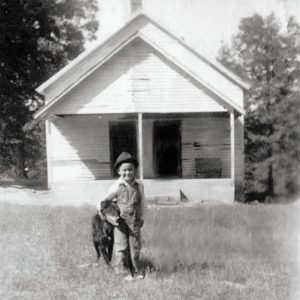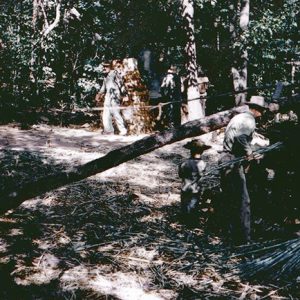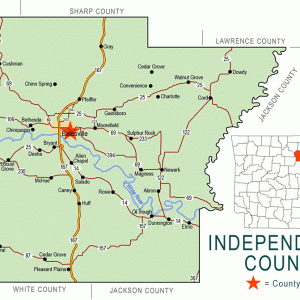calsfoundation@cals.org
Harmontown (Independence County)
Harmontown (a.k.a. Harmon Town) is a farming community in Washington Township, located on Harmontown Road between Bethesda (Independence County) and O’Neal (Independence County). Willow and Pine Tree lanes circle the community near Harmon and Betsey Gill creeks. Harmontown is in the White River bottoms about a mile north of the river. The White River bottoms are noted for floods, often severe. About ten miles west of the county seat of Batesville (Independence County), Harmontown is about two and a half miles from Bethesda and about three miles from O’Neal.
The Harmon family from Tennessee founded the community. Stephen William (Step) Harmon and his wife, Sarah Mary Luster Harmon, along with four of their five sons (Moses, Peter, Trent, and Bill), arrived in Arkansas by boat sometime between 1846 and 1849. It appears they were having financial problems in Tennessee, which spurred them to sell out and head west. The family is on the 1850 census for Washington Township. The oldest son, Dooley, joined them with his wife, Nancy Wilson Harmon, sometime in the 1850s. Some members of the family crossed the river and farmed the rich Greenbriar (original spelling) bottoms of Locust Grove. Ferries such as the Greenbriar and Earnheart ferries made it easy for the two branches of the Harmon family to stay in close contact with each other.
Family researchers maintain that water from what became known as the Harmon Spring was a main reason for the Harmon family settling in what became Harmontown. (The fresh-water spring still runs and is often visited by locals as well as travelers.) Step Harmon and his sons were blacksmiths and gunsmiths by trade, and Step was still working at one of his son’s forges when he was eighty-five years old. There are remains of his iron work at the Harmon farm just south of Bethesda. Step and Sarah Harmon are buried in Campground Cemetery at Bethesda.
The Harmon family was firmly established at Harmontown when the Civil War began in 1861. The Harmons opted to fight for the Confederacy, as did a majority of their neighbors in Washington Township. Peter Casper Harmon and his son, James, harassed the Union forces who camped in the area. The two were part of the First Arkansas Cavalry, composed mainly of friends and neighbors and commanded by Captain George Rutherford, who led the Skirmish at Waugh’s Farm, conducting a surprise attack to defeat the Union forces foraging there.
On March 30, 1864, about a month after participating in the Skirmish at Waugh’s Farm and while with the Seventh Arkansas Infantry, Peter and James Harmon were captured on Beech Fork Creek near Prim (Cleburne County) by a Missouri cavalry unit. They were taken to a prison camp in Little Rock (Pulaski County). Peter Harmon died of pneumonia a few weeks later, but James was transferred to a prison camp in Rockford, Illinois, where he remained until the end of the war. Peter Harmon is buried in the Little Rock National Cemetery.
In 1871, the Washington High School Association was established to build a school for the community. The result was the Bethesda Academy, a private school that charged tuition. The academy proved to be difficult to maintain, and it closed in about 1908. The building was torn down and the wood used to build a private residence on the site and to build a Church of Christ. The country school Bell Grove (a.k.a. Belgrove) for grades 1–10 was built at Harmontown around the time the academy closed. By the late 1940s, Bell Grove had merged with Bethesda, and the building was torn down for lumber. Bethesda divided its district for consolidation purposes. On January 25, 1949, part of the Bethesda district was annexed to Cushman (Independence County) and the other part to Batesville. Bethesda kept an elementary school until the 1960s.
The Union Pacific Railroad runs along the eastern banks of White River near Harmontown. The St. Louis, Iron Mountain and Southern Railroad first arrived in Batesville in 1883 and was extended up the White River valley in 1905. It merged with the Missouri Pacific in 1917, which in turn was merged into the Union Pacific Railroad in 1982.
Harmontown never had a post office. Only a few farms, owned and operated mainly by descendants of the Harmon family, are at Harmontown today. The forty-acre Independence Baptist Camp is located at Harmontown on Bell Grove Road. The camp is open from May through October, although the lodge is open year round. Besides use as a church camp, the retreat is available for family reunions and business meetings.
For additional information:
McGinnis, A. C. “A History of Independence County, Ark.” Special issue. Independence County Chronicle 17 (April 1976).
Weaver, Kathleen. “Moses Harmon of Harmontown.” Independence County Chronicle 16 (July 1975): 31–36.
Kenneth Rorie
Van Buren, Arkansas
 Bell Grove School
Bell Grove School  Harmon Sorghum Mill
Harmon Sorghum Mill  Independence County Map
Independence County Map 




Comments
No comments on this entry yet.